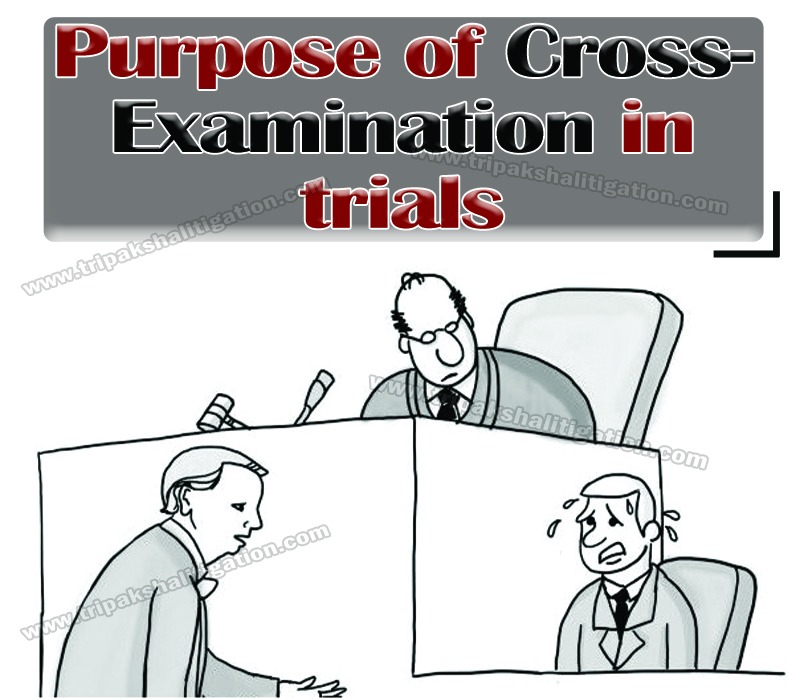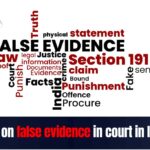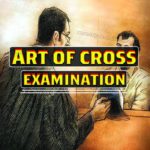The purpose of cross-examination is to test the credibility of statements made during direct examination. Importantly purpose of cross-examination is to attempt to destroy the testimony and/or the credibility of the opponent’s witnesses as Justice is not served if a witness is unable to communicate credibility to a jury. The search for truth is the ultimate and idealistic end of all litigated matter in a court trial: Benjamin J. Cantor, J.D.
INTRODUCTION
A Cross examination is defined as the method that lawyers use to get information from a witness. The information that the witness gives is testimony, during a cross examination.
It is important that laws and regulations are promulgated in order to avoid a state of lawlessness, hence the need to explore the Indian law as well as peruse through the cross examination process in India. Cross examination is an important tool during a legal tussle in a court of competent jurisdiction going to the fact that it is one of the viable means through which the truth can be separated from falls for cross examination is more than the simple process of building questions.
After defining the purpose of cross-examination tersely, it becomes of grave pertinence as how one can create an effective cross-examination.
This could be easily ascertained by few simply yet logical assessment.
Do I Need to Cross-Examine the Witness?
Many lawyers launch forth like lemmings jumping off a cliff and cross-examine witnesses without asking the question: do I need to cross-examine this witness? Some lawyers believe they are not doing their job if they do not ask at least some questions of a witness. But, often, cross-examination will add nothing to your case. If cross-examination of a witness does not help your case, then let the witness go without asking a question. Witnesses who present only foundational facts should not be cross-examined. Likewise even important witnesses who are not likely to be shaken from their direct testimony should not be cross-examined as you will only reinforce the testimony through your questions.
Determining Goals for the Witness.
In developing your cross-examination plan, determine what your goal is. Is the primary purpose of cross-examination to attack the witness’s credibility? Is it your plan to have the witness concede key facts you will not be able to obtain from other witnesses? Is it your plan to have a particular witness confirm key elements of your own case? If your goal is both to elicit important testimony from an adverse witness as well as destroy her credibility on other points, then elicit the helpful testimony before you have destroyed her credibility. Otherwise, you may undermine the helpful information you want from the witness.
Making Sure a Cross-Examination is as per Plan.
Every cross-examination should be planned. Usually, attorneys who “wing it” on cross-examination are ineffective – or worse – become victims of their own questions. For the overwhelming majority of advocates, preparing cross-examination in writing is essential. At a minimum, you will need to prepare a written outline of the points you want to make and have ready citation to exhibits or transcripts for impeachment if you catch the witness in a lie. Judges get impatient seeing lawyers fumbling through a transcript desperately trying to find a point of impeachment. Moreover, by the time the fumbling lawyer finds the impeaching point, judges have often forgotten the purpose of the impeachment. Worse yet, if the attorney cannot find the point of impeachment while the judge is waiting, the attorney looks silly and the witness looks even more credible. Effective cross-examination requires the cross-examining attorney to be able to challenge an incorrect answer in a moment’s notice. In addition, effective cross-examination does not move from one point, to another point, and then back to a first point. Disjointed cross-examination comes off as scattered and confusing. The more you can tie cross-examination to particular subject matters in an organized fashion, the easier it will be for judge to understand exactly where you are going and the easier it will be for you to make your point.
Keep it Short and knowing when to stop.
In direct examination, we lay out a detailed story to present our case. Effective direct examination can last all day as the witness paints a detailed picture of the case through your questioning. In cross-examination, goal is simply to undermine the other side’s story or to confirm points in our story. Virtually every question in cross-examination either makes a point or sets up the next question that will make a point. Meandering cross-examination that goes nowhere bores judges and accomplishes nothing. The overwhelming majority of witnesses can be cross-examined in 30 minutes or less even in very complicated cases. Effective cross-examination makes a point quickly and keeps the judge engaged from the moment you ask your first question until you pass the witness for re-direct. Generally, the longer cross-examination goes on, the less effective it becomes. Unfortunately, the cross-examining attorney can cross the line from effective advocate on top of the case to a brutal bully who does not know when to quit. Once you know an adverse witness has been destroyed, end the cross-examination.
Aim of cross-examination:
Destroying the Witness’s Credibility
There are numerous ways to destroy a witness’s credibility. Each approach depends upon the witness and what you hope to accomplish, these aims can be achieved by using the simple tactics like that of:
A). Attacking the Witness’s Ability to Perceive.
A witness’s testimony is only as strong as his ability to perceive the events relevant to the testimony. Where you are confronted with a seemingly honest witness with no ax to grind who has damaging evidence to present, attack the witness’s ability to perceive the events at issue. There are numerous ways to attack a witness’s ability to perceive. It is possible to show the witness was not present when certain events occurred.
B). Attacking Reliability.
Sometimes, a third-party witness may be truthful but her testimony is not reliable. For instance, a witness who previously made mistakes regarding dates, times, and places may be attempting to tell the truth, but there is a question as to whether the witness can accurately testify to events. In this type of approach, the intent is not to show the witness is lying but that the witness cannot be counted upon to testify accurately to what occurred. This is one of the rare cases where the cross-examining lawyer may want to pile on a number of seemingly innocuous mistakes, which, by themselves are meaningless. However, the repeated mistakes in such a short period of time should cause a judge to question whether this witness can present reliable testimony.
Preparation of cross-examination:
A Lawyer you must prepare himself adequately for upcoming cross examination he should read all the relevant information contained including the police report, FIR and statements he must know everything about the offence of the accused that is alleged to be committed this preparation will enable him to point out any omission or contradiction that had existed during the examination in chief it must be noted that if a lawyer does not call out the omissions and contradictions observed during the cross-examination period he will not be able to be permitted to point out in the future trial.
How is cross-examination conducted.
Cross examination comes with the rules which must be strictly adhered to for the purpose to be successful and exciting.
An effective cross examination must begin with the deposition: It is not ideal for one to wait until trial before preparing cross examination outlines. Each of your expected questions must be asked at the position so you can understand the answers you will receive a trial. If the answer is what you want then you have to have your questions ready for trial.
Do not ask a question that you aren’t sure of the answer: The trial is not the time for you to become amazed by answers you receive any surprises and with your investigating or receiving response during interrogations answer you need must be gotten during the disposition when you do your disposition work correctly then you will get the anticipated answer at trial.
Include only one fact in a question: Avoid compounding the questions with many facts keep it simple by including just one factor question. When the question or less cumbersome it becomes clear to your witness and provokes a simple and straight answer single fact questions will offer you the opportunity to ask witness more leading questions that will get a yes answer.
Avoid arguments with witness: It is possible that the cross examination falls out of plan. The witness might turn up against you, such that no matter of your efforts you cannot get the “Yes”. It is wise to stop and move to the next question
Start it strong and end it strong: While organizing your outline it is ideal to start the topics that will hit the nail on the head and toast with another strong topic.
Avoid asking ultimate questions: After you have succeeded in getting the witness to agree to all of your questions you would wish to land at the ultimate question avoid it you will not always get the answer you want.
Cross examination in Indian context:
The solemn aim of all justice delivery system universally is discovery and ascertainment of truth and truth alone. Cross examination is a vital feature of all modern system of evidence. It is most effective of all means and measures for extracting truth and exposing falsehood.
Cross-examination though is very powerful, effective and efficacious instrument, but experiences reveal that it has to be handled with all emotional intelligence available to its user. In fact it is doubled edged weapon. It often wounds him who wields it and flourished to whom it is aimed. Every Indian with a heavy heart feels that in India an impartial witness is rarely found. Further Indian society is divided into various segments on basics of religion, creed, castes, sub caste and race. Tendency of mixing innocent persons with wrong doers is also found here. This peculiar feature of Indian Justice System has further made the task of cross-examiner more onerous and complicated.
Provisions as to law of cross examination in India:
The relevant provisions as to cross-examination, which precedes examination in chief and which follows re-examination, may usefully be found in chapter X under title “Of the examination of witnesses” of the INDIAN EVIDENCE ACT, 1872.
This chapter X, which is the last chapter of the said ACT, consists of 33 sections spreading from section 135 to 166.
Cross –examination is not the only method to discredit a witness:
Cross-examination is not the only method of discrediting a witness. In case the oral testimony of certain witnesses is contrary to proved facts, their evidence might well be discarded on that ground. If their testimony is on the face of it, unacceptable, court is not bound to accept the same merely because there was no cross-examination.
The scheme of chapter X would primarily deal in:
- Examination of witnesses in chief.
- Their cross-examination.
- The method of impeaching the credit of witnesses.
- Judge’s power to put question or production.
Conclusion:
Effective cross-examination can make the difference between winning and losing a trial. Although cross-examination can be the part of trial that is the most fun for experienced trial lawyers, preparing good cross-examination takes a lot of thought and hard work.
Virtually every one has seen a courtroom drama. Everyone comes to expect that one of the fun parts of watching a trial is watching effective cross-examination from a skilled attorney. Arrange your cross-examination to make sure it has maximum dramatic effect – without being overly dramatic. For example, when a witness under cross-examination admits she previously provided false testimony, let the answer quietly hang in the air before moving to your next question. Let judge absorb what they just heard. The silence can often create more impact than the answer itself. Keep track of your voice tone. Make sure the jury knows you do not believe the witness, without being condescending or snippy.
As with every component of the case, consider using technology to help judges understand what the testimony is. While you and the witness might easily understand what paragraph seven of the contract says and how it contradicts the witness’s testimony, judges may start daydreaming if they cannot see the actual language of paragraphs. Make sure judges can see important demonstrative evidence or key documents, so they understand where you are going with cross-examination.
Assuming you already incorporate technology into your trial presentation, play inconsistent videotape deposition excerpts, rather than just reading the testimony from a cold transcript. It is much more interesting for judge to hear a witness testify inconsistently with testimony they heard just a moment before than to listen to a dry reading.
Cross examination allows the veracity of a witness to be challenged through questions directed at his status in life conduct or previous conviction by a competent court. It has rules which must be discussed as an independent course in law schools in India it is true that the aspect of cross examination is a difficult task which requires one to continuously groom his skills to match the challenging in the legal profession.
You may contact me for consultation or advice by visiting Contact Us








